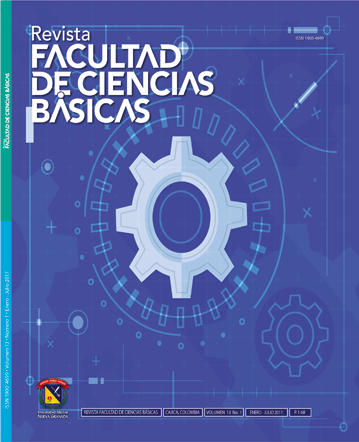Degradación fotocatalítica del colorante amarillo reactivo 145 empleando estructuras de Fe(iii)-TiO2 sintetizadas del mineral ilmenita
Abstract
En el presente trabajo se llevó a cabo la degradación (decoloración) fotocatalítica heterogénea del colorante textil “amarillo reactivo 145” en medio acuoso, empleando un conjunto de sólidos de dióxido de titanio dopado con Fe3+, Fe(III)-TiO2, sintetizados a partir del mineral natural ilmenita mediante extracción de especies de titanio-hierro en medio ácido a diferentes temperaturas. Los sólidos se caracterizaron por fluorescencia de rayos X, difracción de rayos X, adsorción de nitrógeno y espectroscopía IR. En todos los casos se halló una estructura de anatasa sustituida con Fe3+, mesoporosa y de área superficial muy importante. Los materiales sintetizados presentaron actividad catalítica elevada en la degradación fotoasistida (con radiación UV) del colorante textil, alcanzando porcentajes de conversión iguales o mayores que 85%, con baja potencia de irradiación (0,4 watts) y condiciones suaves de reacción (presión atmosférica y 25 °C).
Downloads
References
• Azbar N, Yonar T y Kestioglu K. 2004. Comparison of various advanced oxidation processes and chemical treatment methods for COD and color removal from a polyester and acetate fiber dyeing effluent. Chemosphere, 55: 35-43.
• Bokare AD y Choi W. 2014. Review of iron-free Fenton-like systems for activating H2O2 in advanced oxidation processes. Journal of Hazardous Materials, 275: 121–135.
• Carriazo JG, Moreno-Forero M, Molina RA y Moreno S. 2010. Incorporation of titanium and titanium–iron species inside a smectite-type mineral for photocatalysis. Applied Clay Science, 50: 401–408.
• Chernet T. 1999. Effect of mineralogy and texture in the TiO2 pigment production process of the Tellnes ilmenite concentrate. Mineralogy and Petrology, 67: 21-32.
• Colpini LMS, Lenzi GG, Urio MB, Kochepka DM y Alves HJ. 2014. Photodiscoloration of textile reactive dyes on Ni/TiO2 prepared by the impregnation method: Effect of calcination temperature. Journal of Environmental Chemical Engineering, 2: 2365–2371.
• Crediseguro. Informe sector textil y confecciones colombianos. 2010. Medellín, Colombia. Disponible en: http://www.crediseguro.com.co/dmdocuments/INFORME_SECTOR_TEXTIL_Marzo_2010.pdf
• DAMA. 2004. Guía ambiental para el sector textil, Bogotá, Colombia. Disponible en:http://www.minambiente.gov.co/Puerta/destacado/vivienda/gestion_ds_municipal/nuevas_guias/TEXTIL.pdf
• De Souza SM, Bonilla KAS y de Souza AAU. 2010. Removal of COD and color from hydrolyzed textile azo dye by combined ozonation and biological treatment. Journal of Hazardous Materials, 179: 35-42.
• Ganesh I, Kumar PP, Gupta AK, Sekhar PSC, Radha K, Padmanabham G y Sundararajan G.. 2012. Preparation and characterization of Fe-doped TiO2 powders for solar light response and photocatalyticapplications. Processing and Application of Ceram. 6 (1), 21-36.
• García-Muñoz P, Pliego G, Zazo JA, Barbero B, Bahamonde A y Casas JA. 2016. Modified ilmenite as catalyst for CWPO-Photoassisted process under LED Light. Chemical Engineering Journal. In Press. DOI:10.1016/j.cej.2016.05.093.
• Gaya UI y Abdullah AH. 2008. Heterogeneous photocatalytic degradation of organic contaminants over titanium dioxide: A review of fundamentals, progress and problems. Journal of Photochemistry and Photobiology C, 9: 1–12.
• Guimaraes de Oliveira A, Nascimento JP, Gorgulho HF, Martelli PB, Furtado CA, Figueiredo JL. 2016. Electrochemical synthesis of TiO2/Graphene oxide composite films for photocatalytic applications. Journal of Alloys and Compounds, 654: 514-522
• Gül Ş y Özcan-Yıldırım Ö. 2009. Degradation of Reactive Red 194 and Reactive Yellow 145 azo dyes by O3 and H2O2/UV-C processes. Chemical Engineering Journal, 155: 684–690.
• Khataee AR. 2009. Photocatalytic removal of C.I. Basic Red 46 on immobilized TiO2 nanoparticles: Artificial neural network modelling. Environmental Technology, 30: 1155-1168.
• Ministerio del Medio Ambiente. 2001. Guía de Buenas Prácticas para el Sector Textil, Colombia. Disponibles en: http://www.minambiente.gov.co/documentos/Textiles.pdf
• Muñoz M, de Pedro ZM, Casas JA y Rodríguez JJ. 2015. Preparation of magnetite-based catalysts and their application in heterogeneous Fenton oxidation – A review. Applied Catalysis B, 176–177: 249–265.
• Navío JA, Colón G, Macías M, Real C y Litter MI. 1999. Iron-doped titania semiconductor powders prepared by a sol-gel method. Part I: synthesis and characterization. Applied Catalysis A, 177:111-120.
• Oller I, Malato S y Sánchez-Pérez JA. 2011. Combination of Advanced Oxidation Processes and biological treatments for wastewater decontamination—A review. Science of the Total Environment, 409: 4141-4166.
• Patil NN y Shukla SR. 2015. Degradation of reactive yellow 145 dye by persulfate usingmicrowave and conventional heating. Journal of Water Process Engineering, 7: 314–327.
• Rauf MA, Meetani MA, Hisaindee S. 2011. An overview on the photocatalytic degradation of azo dyes in the presence of TiO2 doped with selective transition metals. Desalination, 276: 13-27.
• Robinson T, McMullan G, Marchant R y Nigam P. 2001. Remediation of dyes in textile effluent: a critical review on current treatment technologies with a proposed alternative. Bioresource and Technology, 77: 247-255.
• Sasikumar C, Rao DS, Srikanth S, Ravikumar B, Mukhopadhyay NK y Mehrotra SP. 2004. Effect of mechanical activation on the kinetics of sulfuric acid leaching of beach sand ilmenite from Orissa, India. Hydrometallurgy, 75: 189-204.
• Sathishkumar P, Anandan S, Maruthamuthu P, Swaminathan T, Zhou M y Ashokkumar M. 2011. Synthesis of Fe3+ doped TiO2 photocatalysts for the visible assisted degradation of an azo dye. Colloids and Surfaces A: Physicochemical Engineering Aspects, 375: 231-236.
• Teoh WY, Amal R, Mädler L y Pratsinis SE. 2007. Flame sprayed visible light-active Fe-TiO2 for photomineralisation of oxalic acid. Catalysis Today, 120: 203–213.
• Torres-Luna JA, Carriazo JG y Sanabria NR. 2014. Efecto de la temperatura de calcinación en las propiedades texturales y estructurales de Fe(III)-TiO2. Revista Facultad de Ciencias Básicas, 10: 186-195.
• Torres-Luna JA, Carriazo JG y Sanabria NR. 2016. Delaminated montmorillonite with iron(III)-TiO2 species as a photocatalyst for removal of a textile azo-dye from aqueous solution. Environmental Technology, 37: 1346-1356.
• Verma AK, Dash RR y Bhunia P. 2012. A review on chemical coagulation/flocculation technologies for removal of colour from textile wastewaters. Journal of Environmental Management, 93: 154-168.
• Zaharia C y Suteu D. 2012.Textile Organic Dyes – Characteristics, Polluting Effects and Separation/Elimination Procedures from Industrial Effluents – A Critical Overview. En: Puzyn T y Mostrag-Szlichtyng A (Eds.). Organic Pollutants Ten Years after the Stockholm Convention - Environmental and Analytical Update, INTECH, Rijeka, Croatia, pp. 55-86.
• Zhang X, Zhou M y Lei L. 2006. Co-deposition of photocatalytic Fe doped TiO2 coatings by MOCVD. Catalysis Communication, 7: 427–431.












